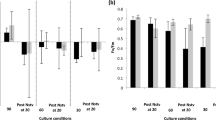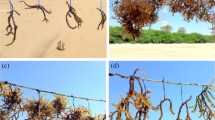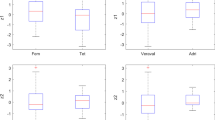Abstract
The rhodophyte seaweed genus Gracilaria is fast replacing Gelidium in global agar trade. Recently, Gracilaria dura from Indian waters has emerged as species of choice due to its quality agarose. The triphasic life cycle provides an opportunity for selecting an elite cultivar. Here we report diversity pertaining to functional traits over 3 months (January, February and March) among two distinct life phases, the tetrasporophyte and the female gametophyte. It was evident that functional trait related to growth was distinct in tetrasporophytes than in female gametophytes; while those of survival (antioxidant, proximate composition and pigments) were prominent in female gametophytes. Both the lowest 3.42 ± 0.38% day−1 (female gametophytes) and highest 5.17 ± 0. 21% day−1 (terasporophytes) growth rates were in January with 33% higher growth in the latter. Of the survival traits, antioxidant potential ranged from 0.51 ± 0.08 to 1.1 ± 0.03 mg g−1 FW ascorbic acid equivalent. Furthermore, female gametophytes collected in March reported 53.60%, 28.40% and 50.40% higher activity than the tetrasporophytes of January, February and March, respectively. The female gametophyte in March showed 23% and 19.40% higher protein content than the tetrasporophytes of January and February, respectively. Sixty-one metabolites were identified of which 29 were common, with sugars as the major portion (77.69% in February to 89.38% in January) and amine derivatives the least (0.30% in January to 0.51% in February). Studies of bio-ecophysiology of this alga are currently being undertaken by our group.




Similar content being viewed by others
References
Araújo FO, Ursi S, Plastino EM (2014) Intraspecific variation in Gracilaria caudata (Gracilariales, Rhodophyta): growth, pigment content, and photosynthesis. J Appl Phycol 26:849–858
Baghel RS, Kumari P, Bijo AJ, Gupta V, Reddy CRK, Jha B (2011) Genetic analysis and marker assisted identification of life phases of red alga Gracilaria corticata (J. Agardh). Mol Biol Rep 38:4211–4218
Baghel RS, Trivedi N, Gupta V, Neori A, Reddy CRK, Lali A, Jha B (2015) Biorefining of marine macroalgal biomass for production of biofuel and commodity chemicals. Green Chem 17:2436–2443
Barufi JB, De Oliveira EC, Plastino EM, De Oliveira MC (2010) Life history, morphological variability and growth rates of the life phases of Gracilaria tenuistipitata (Rhodophyta: Gracilariales) in vitro. Sci Mar 74:297–303
Bligh EG, Dyer WJ (1959) A rapid method of total lipid extraction and purification. Can J Biochem Physiol 37:911–917
Belghit I, Rasinger JD, Heesch S, Biancarosa I, Liland N, Torstensen B, Waagbø R, Lock E-J, Bruckner CG (2017) In-depth metabolic profiling of marine macroalgae confirms strong biochemical differences between brown, red and green algae. Algal Res 26:240–249
DeBusk TA, Ryther JH (1984) Effects of seawater exchange, pH and carbon supply on growth of Gracilaria tikvaiae (Rhodophyceae) in large scale cultures. Bot Mar 27:357–362
Destombe C, Valero M, Vernet P, Couvet D (1989) What controls haploid—diploid ratio in the red alga, Gracilaria verrucosa? J Evol Biol 2:317–338
Di Rienzo J A, Casanoves F, Balzarini M G, Gonzalez L, Tablada M, Robledo CW InfoStat versión (2018). Centro de Transferencia InfoStat, Facultad de Ciencias Agropecuarias, Universidad Nacional de Córdoba, Argentina. URL http://www.infostat.com.ar
FAO (1991). Seaweed (Gracilaria edulis) farming in Vedalai and Chinnapalam. Bay of Bengal Programme Small Scale Fisher Folk Communities. (Eds.) Kalkam I, Rajendran I, Angell CL. Food and Agriculture Organization of United Nations, Rome Publication BOBP/WP/65, 11 pp.
Ganesan M, Eswaran K, Reddy CRK (2017) Farming of agarophytes in India - a long-time sustainability for the industry and preserving wild stocks. J Appl Phycol 29:2239–2248
Ganesan M, Trivedi N, Gupta V, Venu Madhav S, Reddy CRK, Levine I (2019). Seaweed resources in India – current status of diversity and cultivation: prospects and challenges. Bot Mar. https://doi.org/10.1515/bot-2018-0056
Guillemin ML, Valenzuela P, Gaitán-Espitia JD, Destombe C (2014) Evidence of reproductive cost in the triphasic life history of the red alga Gracilaria chilensis (Gracilariales, Rhodophyta). J Appl Phycol 26:569–575
Guimarães M, Plastino EM, Oliveira ECD (1999) Life history, reproduction and growth of Gracilaria domingensis (Gracilariales, Rhodophyta) from Brazil. Bot Mar 42:481–486
Gupta V, Baghel RS, Kumar M, Kumari P, Mantri VA, Reddy CRK, Jha B (2011) Growth and agarose characteristics of isomorphic gametophyte (male and female) and sporophyte of Gracilaria dura and their marker assisted selection. Aquaculture 318:389–396
Hong DD, Hien HM, Son PN (2007) Seaweeds from Vietnam used for functional food, medicine and biofertilizer. J Appl Phycol 19:817–826
Jeffrey ST, Humphrey GF (1975) New spectrophotometric equations for determining chlorophylls a, b, c1 and c2 in higher plants, algae and natural phytoplankton. Biochem Physiol Pflanz 167:191–194
Kaladharan P, Vijayakumaran K, Chennubhotla VSK (1996) Optimization of certain physical parameters for the mariculture of Gracilaria edulis (Gmelin) Silva in Minicoy lagoon (Laccadive Archipelago). Aquaculture 139:265–270
Kuda T, Hishi T, Maekawa S (2006) Antioxidant properties of dried product of ‘haba-nori’, an edible brown alga, Petalonia binghamiae (J. Agaradh) Vinogradova. Food Chem 98:545–550
Kumar GR, Reddy CRK, Jha B (2007) Callus induction and thallus regeneration from callus of phycocolloid yielding seaweeds from the Indian coast. J Appl Phycol 19:15–25
Kumar M, Kumari P, Trivedi N, Shukla MK, Gupta V, Reddy CRK, Jha B (2011) Minerals, PUFAs and antioxidant properties of some tropical seaweeds from Saurashtra coast of India. J Appl Phycol 23:797–810
Lisec J, Schauer N, Kopka J, Willmitzer L, Fernie AR (2015) Corrigendum: gas chromatography mass spectrometry-based metabolite profiling in plants. Nat Protoc 10:10–1038
Lowry O, Rosebrough N, Farr A, Randall R (1951) Protein measurement with Folin phenol reagent. J Biol Chem 193:265–275
Mantri VA (2010). Studies on biology of Gracilria dura (C. Agardh) J. Agardh. PhD Thesis, Bhavnagar University, Bhavnagar, India 119 pp.
Mantri VA, Shah Y, Thiruppathi S (2020) Feasibility of farming the agarose-yielding red alga Gracilaria dura using tube-net cultivation in the open sea along the Gujarat coast of NW India. Appl Phycol 1:12–19
Mantri VA, Ganesan M, Gupta V, Krishnan P, Siddhanta AK (2019) An overview on agarophyte trade in India and need for policy interventions. J Appl Phycol 31:3011–3023
Marinho-Soriano E, Bourret E (2005). Polysaccharides from the red seaweed Gracilaria dura (Gracilariales, Rhodophyta). Bioresour Technol 96(3):379–382
Marinho-Soriano E, Bourret E, De Casabianca ML, Maury L (1999) Agar from the reproductive and vegetative stages of Gracilaria bursa-pastoris. Bioresour Technol 67:1–5
Marirajan T, Hoon V, Alicea E (2012) Socio economic monitoring for coastal managers of South Asia: field trials and baseline surveys in Gulf of Mannar region, South Tamilnadu, India: project completion report, NA10NOS4630055
Meena R, Prasad K, Ganesan M, Siddhanta AK (2008) Superior quality agar from Gracilaria species (Gracilariales, Rhodophyta) collected from the Gulf of Mannar, India. J Appl Phycol 20:397–402
Meena R, Siddhanta AK, Prasad K, Ramavat BK, Eswaran K, Thiruppathi S, Rao PS (2007) Preparation, characterization and benchmarking of agarose from Gracilaria dura of Indian waters. Carbohydr Polym 69:179–188
Meena R, Chaudhary JP, Agarwal PK, Maiti P, Chatterjee S, Raval HD, Agarwal P, Siddhanta AK, Prasad K, Ghosh PK (2014) Surfactentinduced coagulation of agarose from aqueous extract of Gracilaria dura seaweed as an energy-efficient alternative to the conventional freeze-thaw process. RSC Adv 4:28093–28098
Mehta GK, Meena R, Prasad K, Ganesan M, Siddhanta AK (2010) Preparation of galactans from Gracilaria debilis and Gracilaria salicornia (Gracilariales, Rhodophyta) of Indian waters. J Appl Phycol 22:623–627
Murano E, Toffanin R, Zanetti F, Knutsen S H, Paoletti S, Rizzo R (1992). Chemical and macromolecular characterisation of agar polymers from Gracilaria dura (C. Agardh) J. Agardh (Gracilariaceae, Rhodophyta). Carbohyd Polym 18(3):171–178
Oza RM (1971) Effect of lAA on the growth of fragment of Gracilaria corticata. J Ag Seaweed Res Util 1:48–49
Oza R M, Tewari A, Rajyaguru M R, Goswamy S (1994). Laboratory and field culture of marine red alga Gracilaria verrucosa (Gracilariaceae, Rhodophyta). Indian J Mar Sci 23:157–161
Oza RM, Zaidi SH (2001) A revised checklist of Indian marine algae. CSMCRI, Bhavnagar, 296
Patwary MU, Van der Meer JP (1992) Genetics and breeding of cultivated seaweeds. Korean J Phycol 7:281–318
Patwary MU (1987) Frond composition and some physical characteristics of agars from female, male and tetrasporophyte clones of Gracilaria tikvhiae mutant MP-40. Bangladesh J Bot 16:211–224
Porse H, Rudolph B (2017) The seaweed hydrocolloid industry: 2016 updates, requirements, and outlook. J Appl Phycol 29:2187–2200
Prieto P, Pineda M, Aguilar M (1999) Spectrophotometric quantitation of antioxidant capacity through the formation of a phosphomolybdenum complex: specific application to the determination of vitamin E. Anal Biochem 269:337–341
Raikar SV, Iima M, Fujita Y (2001) Effect of temperature, salinity and light intensity on the growth of Gracilaria spp. (Gracilariales, Rhodophyta) from Japan, Malaysia and India. Indian J Mar Sci 30:98–104
Raju PV, Thomas PC (1971) Experimental field cultivation of Gracilaria edulis (Gmel.) Silva. Bot Mar 14:71–75
Sampath-Wiley P, Neefus CD (2007) An improved method for estimating R-phycoerythrin and R-phycocyanin contents from crude aqueous extracts of Porphyra (Bangiales, Rhodophyta). J Appl Phycol 19:123–129
Santelices B (1992) Strain selection of clonal seaweeds. Prog Phycol Res 8:85–116
Scrosati R, DeWreede RE (1999) Demographic models to simulate the stable ratio between ecologically similar gametophytes and tetrasporophytes in populations of the Gigartinaceae (Rhodophyta). Phycol Res 47:153–157
Sharma S, Chen C, Khatri K, Rathore MS, Pandey SP (2019) Gracilaria dura extract confers drought tolerance in wheat by modulating abscisic acid homeostasis. Plant Physiol Biochem 136:143–154
Skriptsova AV, Nabivailo YV (2009) Comparison of three gracilarioids: growth rate, agar content and quality. J Appl Phycol 21:443–450
Subbaramaiah K, Thomas PC (1990) Raft cultivation of Gracilaria edulis (Gmel.) Silva. Proc Indian Acad Sci (Plant Sci) 100:123–127
Suto S (1959) Skeletonema no tame no jinkou baiyoueki. Suisan-Zouskoku. 7:17–19 [in Japanese]
Umamaheswara Rao M (1974) On the cultivation of Gracilaria edulis in the near shore areas around Mandapam. Curr Sci 43:660–661
Ursi S, Plastino EM (2001) Crescimento in vitro de linhagens de coloração vermelha e verde clara de Gracilaria sp. (Gracilariales, Rhodophyta) em dois meios de cultura: análise de diferentes estádios reprodutivos. Rev Bras Bot 4:585–592
Van der Meer JP, Bird NL (1977) Genetics of Gracilaria sp. (Rhodophyceae, Gigartinales) I. Mendelian inheritance of two spontaneous green variants. Phycologia 16:159–161
Veeragurunathan V, Eswaran K, Malarvizhi J, Gobalakrishnan M (2015a) Cultivation of Gracilaria dura in the open sea along the southeast coast of India. J Appl Phycol 27:2353–2365
Veeragurunathan V, Eswaran K, Saminathan KR, Mantri VA, Ajay G, Jha B (2015b) Feasibility of Gracilaria dura cultivation in the open sea on the South-eastern coast of India. Aquaculture 438:68–74
Veeragurunathan V, Prasad K, Malarvizhi J, Singh N, Meena R, Mantri VA (2019) Gracilaria debilis cultivation, agar characterization and economics: bringing new species in the ambit of commercial farming in India. J Appl Phycol 31:2609–2621
Vieira VMNCS, Engelen AH, Huanel OR, Guillemin ML (2018) Haploid females in the isomorphic biphasic life-cycle of Gracilaria chilensis excel in survival. BMC Evol Biol 18:174
Zhang XC, Fei XG (1990) Cultivation and hybridization experiments on Gracilaria tenuistipitata (Rhodophyta). In Current topics in marine biotechnology, Proceeding of the 1st International Marine Biotechnology Conference on Sep 4-6 in Tokyo p 203-214
Zheng Y, Gao K (2009) Impacts of solar UV radiation on the photosynthesis, growth, and UV-absorbing compounds in Gracilaria lemaneiformis (Rhodophyta) grown at different nitrate concentrations. J Phycol 45:314–323
Acknowledgements
The first author gratefully acknowledges the University Grant Commission (UGC). We are grateful to the Director, CSIR-CSMCRI for the encouragement. Thanks are also due to Dr. Monica G. Kavale for identifying life cycle phases during sampling and Mr. K. Vijayanand for helping in statistical analysis. Dr. Nikunj Balar, Ms. Tejal Gajaria, Mr. Shahrukh Siddiqui, Mr. Prashant More and Mr. Smit Goswami have rendered support during manuscript preparation.
Funding
This work was carried out by a grant received from Council for Scientific and Industrial Research (CSIR), New Delhi, Government of India.
Author information
Authors and Affiliations
Corresponding author
Additional information
Publisher’s note
Springer Nature remains neutral with regard to jurisdictional claims in published maps and institutional affiliations.
Electronic supplementary material
ESM 1
(DOCX 413 kb)
Rights and permissions
About this article
Cite this article
Sambhwani, K., Modi, J., Singhala, A. et al. Analysis of functional traits in female gametophytic and tetrasporophytic life phases of industrially important red alga Gracilaria dura (Rhodophyta: Gracilariacae). J Appl Phycol 32, 1961–1969 (2020). https://doi.org/10.1007/s10811-020-02116-1
Received:
Revised:
Accepted:
Published:
Issue Date:
DOI: https://doi.org/10.1007/s10811-020-02116-1




